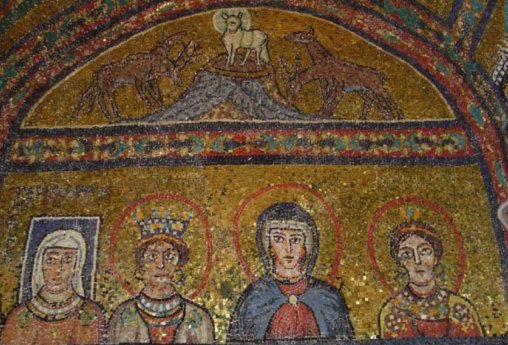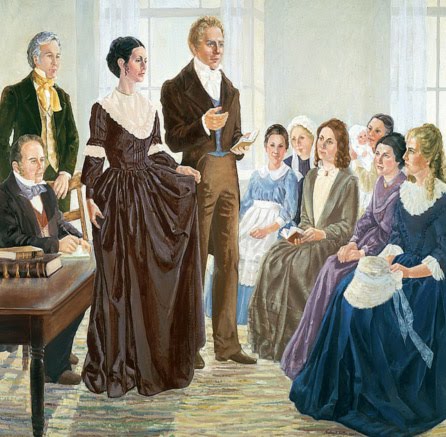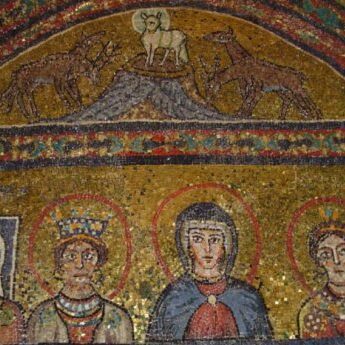
“Episcopa Theodora“, 9th century mosaic in the St. Zeno Chapel of the Church of St. Praxedis in Rome. Image source
Background:
The LDS Bible Dictionary says this about the three epistles of John:
” In none of these three epistles does the writer mention himself by name; but tradition assigns them to John, while the similarity of the language of these epistles and that of the fourth Gospel is strongly marked…The second epistle is closely connected with the first in the character of the false teaching it condemns. The “elect lady” addressed in it is nameless. The writer of the letter styles himself the “Elder.”
Facts About Her:
- She was a mother (vs 1);
- John (the beloved) wrote an epistle directly to her. It is the only epistle in the New Testament written to a woman (vs 1);
- She was loved by John as well as “…all they that have known the truth” (vs. 1);
- Her children were walking in faith;
- John blessed her to “love one another” and to beware of deceivers and antichrists and not to receive any into her house, nor bid him “God speed” who professed that doctrine (vs. 6-7);
- John has more to say to her but tells her that he will come visit her and tell her more that they may, “…speak face to face, that our joy may be full.” (vs. 12)
- She has a sister who is also “elect” and John tells her that, “The children of thy elect sister greet thee” (vs. 13).
- We don’t know if the “sister” John mentions in vs. 13 is her real sister or a sister in the gospel. It could be either;
- Some Christians interpret phrase “the elect lady and her children” as an analogy for the Church of Christ. They feel that John wasn’t writing to a specific person but rather to a group of Christians whom he addressed this way, much in the same way that Christ talks about the Church being “his bride” (John 3:29).
My Thoughts:
I’ve been thinking a lot about this unnamed woman in the New Testament the last few months. As lots of my readers know a few months ago our Relief Society re-enacted the first meeting of the Relief Society using a script that I wrote from Eliza R. Snow’s original notes of the 1st meeting in Nauvoo.
As I was putting together our re-enactment Joseph Smith’s comparison of Emma Smith to the “elect lady” in 2 John really got me excited.
According to Eliza’s notes after Emma Smith was elected and sustained as president of the Relief Society Joseph Smith stood and read the entire 25th Section of the Doctrine and Covenants (which is a revelation addressed specifically to Emma Smith) and then he told the women this (these quotes are word for word from Eliza’s notes):
“This revelation was given to me in July of 1830, not long after the church was first organized. Emma was ordained at that time to expound the scriptures to all and to teach the female part of the community. She is not alone in this but others may also obtain to the same blessings.”
Joseph then opened the New Testament and read all of 2 John (which is the epistle directed to the “elect lady”) after which he told the women:
“I read this verse to you to show that respect is had to the same thing and that why she was called an elect lady is because she was elected to preside.”
He then asks if Elder John Taylor would, “… set apart the elect lady [referring to Emma] and her counselors…”

It was really powerful to me that Joseph explained that the reason a woman is called “elect” is because she is elected and has been set apart to preside, in this case over the women of the church. It makes me wonder if perhaps this “elect lady” mentioned in 2 John might not have been the New Testament version of a General Relief Society president. Perhaps the reason why Joseph Smith compares Emma to this elect lady is because, as he said, “respect is had to the same thing…” and that in being called and set apart as the Relief Society president for the restored church Emma was filling the same role that the elect lady filled in the New Testament church.
In her talk, “Fulfilling the Purpose of Relief Society” Julie Beck explains that such a thing could have been possible. She says:
Since its organization, Relief Society has spread throughout the world and has been called “the largest, and by all measure, the greatest women’s organization on earth.”4 We know through the Prophet Joseph Smith that Relief Society was a formal part of the Restoration and that a similar organization for women existed in the Church anciently.5The Prophet Joseph taught that Relief Society was “divinely made, divinely authorized, divinely instituted, divinely ordained of God,”6 “according to the law of heaven”7 to help the Lord “bring to pass the . . . eternal life of man.”8 I’ve mentioned before about how powerful it is to me to know that the Relief Society (or something similar) was organized in Christ’s day. To know that the women were organized and had a specific role and work to do Christ’s work completely changes how I read the New Testament. It thills me to think about there being an ancient relief society, with a president who was elected and given power to preside and “expound the scriptures” to the women of the church. I can’t help wonder about her who her counselors would have been (maybe the other “elect” sister John mentions)? What would her jobs have been? What were the needs of the saints in her day? How did she met them? What sort of interaction did she have with the prophets and apostles? Did she personally know Christ? Could she possibly have been one of the women at the empty tomb?
I have a thousand questions I’d like to ask about her… but I guess they will just have to wait.
It is also interesting to note that the only epistle we have in the New Testament that was written to a woman was the one to the “elect lady” and that the only section in the Doctrine and Covenants that was written to a woman is section 25 which was written to Emma Smith, another “elect lady.”
Does that give anyone else little tingles down their spine?
Questions to Think About:
- Who do you think she was that she warranted her own special epistle from an apostle?
- What else did John have to tell her that could only be said “face to face”?
- Why would he warn her about accepting people into her home? Could it be that she was sought out by those who needed relief? Or that the church met at her home?
- How does knowing that the Relief Society was organized in Christ’s day alter your understanding of the New Testament, especially the women in it?
- Who are the “elect ladies” today?
- What do you think Joseph Smith meant when he said, “Emma was ordained at that time to expound the scriptures to all and to teach the female part of the community. She is not alone in this but others may also obtain to the same blessings.“?





I never thought of this, but it makes sense and feels right. What a wonderful thought!
Absolutely thrilling to read!
Very well written and wonderful information.
As I prepared a talk on the subject I really enjoyed going through your blog.
My thoughts… I think John was protecting the identity of this blessed woman and her children. Perhaps this has a link to what John sees and reveals symbolically in Revelation 12:13-17. It is also no surprise that the Savior gave John the task of watching over his own mother while he was crucified. John seems to have been a protector of holy women for the Savior. Perhaps the first and greatest keeper of that which is most sacred.
I love John… And yes this is thrilling. Thanks. I have been thinking about the elect lately. We are you know…